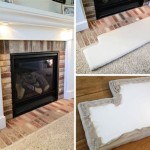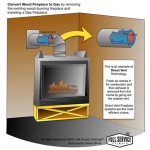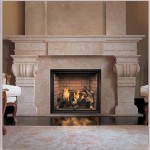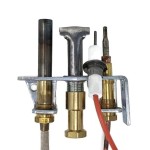Understanding Fireplace Heater Inserts: A Comprehensive Guide
Fireplace heater inserts are self-contained heating units designed to be installed within an existing masonry or prefabricated fireplace. They offer an efficient and aesthetically pleasing alternative to traditional wood-burning fireplaces, providing supplemental heat to a home while often enhancing the visual appeal of the living space.
These inserts typically utilize various fuel sources, including electricity, gas (natural gas or propane), and wood pellets. Each type offers distinct advantages and disadvantages regarding heating efficiency, fuel costs, environmental impact, and installation requirements. Understanding these differences is crucial for homeowners considering adding or replacing a fireplace with an insert.
The primary function of a fireplace heater insert is to increase the heating efficiency of a fireplace. Traditional open-hearth fireplaces are notoriously inefficient, with a significant portion of the heat generated escaping up the chimney. Fireplace inserts are designed to capture and circulate this heat into the room, significantly improving the overall thermal comfort of the space and reducing reliance on other heating systems.
The installation of a fireplace insert typically involves several steps, including preparing the fireplace opening, connecting the necessary fuel and ventilation systems, and ensuring proper sealing and insulation. Professional installation is highly recommended to ensure safety and optimal performance.
The decision to install a fireplace heater insert involves considering several factors. These include the size and layout of the room to be heated, the available fuel sources, the desired level of automation, and the budget for purchase and installation. Understanding these factors will help homeowners select the appropriate type and size of fireplace insert to meet their specific needs.
Benefits of Fireplace Heater Inserts
Fireplace heater inserts offer several advantages over traditional fireplaces. One significant benefit is improved heating efficiency. Inserts are designed to trap and circulate heat, directing it into the room rather than allowing it to escape through the chimney. This can result in a substantial reduction in heating bills and increased comfort during colder months.
Another advantage is enhanced safety. Open-hearth fireplaces can pose safety risks, such as sparks and embers escaping into the room, leading to potential fires. Fireplace inserts are enclosed units that significantly reduce these risks. Many models also include safety features such as automatic shut-off mechanisms and carbon monoxide detectors.
Furthermore, fireplace inserts offer greater control over the heating process. Many models are equipped with thermostats and remote controls, allowing homeowners to easily adjust the temperature and heating output to their desired level. This level of control is not typically available with traditional wood-burning fireplaces.
Lastly, fireplace inserts offer aesthetic improvements. They can transform an outdated or unattractive fireplace into a focal point of the room. A wide variety of styles and finishes are available, allowing homeowners to choose an insert that complements their existing décor.
Types of Fireplace Heater Inserts
There are several main types of fireplace heater inserts, each using a different fuel source and offering unique characteristics. Electric fireplace inserts are a popular choice due to their ease of installation and operation. They require no venting and can be plugged into a standard electrical outlet. Electric inserts typically use heating coils and a fan to circulate warm air into the room. They also often include realistic flame effects for added ambiance.
Gas fireplace inserts are another common option, offering a balance of efficiency and convenience. They can burn either natural gas or propane and require a connection to a gas line. Gas inserts are typically more efficient than electric inserts and can provide more heat output. They also offer a realistic flame appearance. Venting is required for gas inserts to safely exhaust combustion byproducts.
Wood pellet fireplace inserts are a renewable and environmentally friendly option. They burn compressed wood pellets, which are a sustainable fuel source. Pellet inserts are highly efficient and can provide significant heat output. They require a hopper to store the pellets and an auger to feed them into the combustion chamber. Regular cleaning and maintenance are necessary to ensure optimal performance.
Each type of fireplace insert has its unique benefits and drawbacks. Electric inserts are the easiest to install and operate, but may not provide as much heat as gas or pellet inserts. Gas inserts offer a good balance of efficiency and convenience, but require a gas line connection and venting. Wood pellet inserts are a renewable option, but require more maintenance and a dedicated storage space for the pellets.
Factors to Consider When Choosing a Fireplace Heater Insert
Several factors should be carefully considered when selecting a fireplace heater insert to ensure it meets the homeowner's specific needs and preferences. The size of the room to be heated is a primary consideration. A larger room will require a more powerful insert with a higher BTU (British Thermal Unit) rating to effectively heat the space. Conversely, a smaller room may only require a less powerful insert.
The available fuel sources are another crucial factor. If natural gas is readily available, a gas insert may be the most convenient and cost-effective option. If natural gas is not available, propane or electric inserts may be more suitable. Wood pellet inserts require a dedicated storage space for the pellets and may not be practical for all homeowners.
The desired level of automation is also an important consideration. Some inserts offer advanced features such as thermostats, remote controls, and programmable timers. These features can provide greater control over the heating process and enhance convenience. Other inserts may be more basic and require manual operation.
The homeowner's budget is also a significant factor. Fireplace inserts can range in price from a few hundred dollars to several thousand dollars, depending on the type, size, features, and brand. Installation costs should also be factored into the budget. Professional installation is generally recommended to ensure safety and optimal performance.
Finally, the aesthetic appeal of the insert should be considered. A wide variety of styles and finishes are available, so homeowners can choose an insert that complements their existing décor. The insert should be visually appealing and enhance the overall ambiance of the room.
In summary, choosing the right fireplace heater insert requires careful consideration of several factors, including the size of the room, available fuel sources, desired level of automation, budget, and aesthetic appeal. By carefully evaluating these factors, homeowners can select an insert that provides efficient heating, enhanced safety, and aesthetic improvements to their home.
The heat output of a fireplace insert is typically measured in BTUs. A higher BTU rating indicates a greater heating capacity. When selecting an insert, it is important to choose a model with a BTU rating that is appropriate for the size of the room to be heated. A general rule of thumb is to choose an insert with approximately 5,000 BTUs per 200 square feet of living space. However, this is just a guideline, and other factors such as insulation and climate should also be considered.
The efficiency of a fireplace insert refers to its ability to convert fuel into usable heat. A more efficient insert will use less fuel to produce the same amount of heat, resulting in lower heating costs. Efficiency ratings are typically expressed as a percentage. A higher percentage indicates a more efficient insert. When selecting an insert, it is advisable to choose a model with a high efficiency rating to minimize heating costs and environmental impact.
Venting requirements vary depending on the type of fireplace insert. Electric inserts do not require venting, as they do not produce any combustion byproducts. Gas inserts require venting to safely exhaust combustion gases such as carbon monoxide. Wood pellet inserts also require venting to exhaust smoke and other byproducts. The venting system must be properly installed to ensure safe and efficient operation.
Installation costs can vary depending on the type of fireplace insert and the complexity of the installation process. Electric inserts are typically the easiest to install, while gas and wood pellet inserts may require more extensive modifications to the fireplace and venting system. Professional installation is highly recommended to ensure safety and compliance with local building codes.
Maintenance requirements also vary depending on the type of fireplace insert. Electric inserts typically require minimal maintenance, while gas and wood pellet inserts may require regular cleaning and inspection to ensure proper operation. Regular maintenance can help to extend the lifespan of the insert and prevent costly repairs.
The longevity of a fireplace heater insert depends on several factors, including the quality of the unit, the frequency of use, and the level of maintenance. With proper care and maintenance, a well-built fireplace insert can last for many years, providing reliable and efficient heating to the home.

22 5 Electric Fireplace Heater Inserts Recessed Ultra Thin Log Flame 1500w

Costway 28 5 Fireplace Electric Embedded Insert Heater Glass Log Flame Remote Com

Dimplex 24 In Black Electric Fireplace Insert The Inserts Department At Com

Sierra Flame 34 Inch Built In Electric Fireplace Insert Firebox Heater Ins Fm Fireplaces Depot

Edendirect 39 In Ventless Electric Fireplace Insert Remote Control Adjustable Led Flame Brightness 750 Watt 1500 Nblw Ry 939a The Home Depot

26 Electric Fireplace Insert Recessed Heater Bestoutdor

Cambridge 27 In Freestanding 5116 Btu Electric Fireplace Heater Insert With Remote Control And 9 Hour Timer At Tractor Supply Co

Fireplace 26 Electric Inserts 1400w Recessed Heater With Log Set Realistic Flame Remote Control Timer Overheating Protection Com

Amantii Traditional 26 Inch Built In Indoor Outdoor Electric Firebox Insert Fireplace Heater Trd Fireplaces Depot

Dimplex 21 5 In Black Electric Fireplace Insert The Inserts Department At Com
Related Posts








